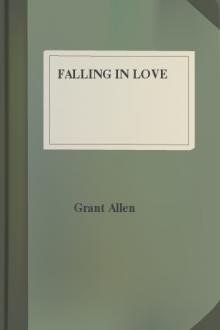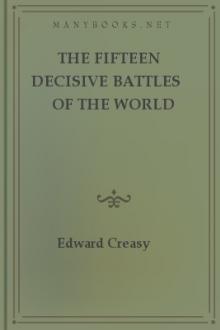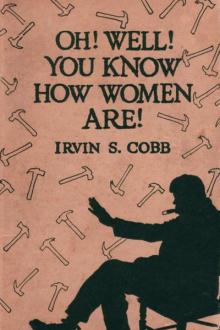Falling in Love by Grant Allen (different e readers .txt) 📕

- Author: Grant Allen
- Performer: -
Book online «Falling in Love by Grant Allen (different e readers .txt) 📕». Author Grant Allen
Running hastily through the chief marsupial developments, one may say that the wombats are pouched animals who take the place of rabbits or marmots in Europe, and resemble them both in burrowing habits and more or less in shape, which closely approaches the familiar and ungraceful guinea-pig outline. The vulpine phalanger does duty for a fox; the fat and sleepy little dormouse phalanger takes the place of a European dormouse. Both are so ridiculously like the analogous animals of the larger continents that the colonists always call them, in perfect good faith, by the familiar names of the old-country creatures. The koala poses as a small bear; the cuscus answers to the racoons of America. The pouched badgers explain themselves at once by their very name, like the Plyants, the Pinchwifes, the Brainsicks, and the Carelesses of the Restoration comedy. The 'native rabbit' of Swan River is a rabbit-like bandicoot; the pouched ant-eater similarly takes the place of the true ant-eaters of other continents. By way of carnivores, the Tasmanian devil is a fierce and savage marsupial analogue of the American wolverine; a smaller species of the same type usurps the name and place of the marten; and the dog-headed Thylacinus is in form and figure precisely like a wolf or a jackal. The pouched weasels are very weasel-like; the kangaroo rats and kangaroo mice run the true rats and mice a close race in every particular. And it is worth notice, in this connection, that the one marsupial family which could compete with higher American life, the opossums, are really, so to speak, the monkey development of the marsupial race. They have opposable thumbs, which make their feet almost into hands; they have prehensile tails, by which they hang from branches in true monkey fashion; they lead an arboreal omnivorous existence; they feed off fruits, birds' eggs, insects, and roots; and altogether they are just active, cunning, intelligent, tree-haunting marsupial spider-monkeys.
Australia has also one still more ancient denizen than any of these, a living fossil of the very oldest sort, a creature of wholly immemorial and primitive antiquity. The story of its discovery teems with the strangest romance of natural history. To those who could appreciate the facts of the case it was just as curious and just as interesting as though we were now to discover somewhere in an unknown island or an African oasis some surviving mammoth, some belated megatherium, or some gigantic and misshapen liassic saurian. Imagine the extinct animals of the Crystal Palace grounds suddenly appearing to our dazzled eyes in a tropical ramble, and you can faintly conceive the delight and astonishment of naturalists at large when the barramunda first 'swam into their ken' in the rivers of Queensland. To be sure, in size and shape this 'extinct fish,' still living and grunting quietly in our midst, is comparatively insignificant beside the 'dragons of the prime' immortalised in a famous stanza by Tennyson: but, to the true enthusiast, size is nothing; and the barramunda is just as much a marvel and a monster as the Atlantosaurus himself would have been if he had suddenly walked upon the stage of time, dragging fifty feet of lizard-like tail in a train behind him. And this is the plain story of that marvellous discovery of a 'missing link' in our own pedigree.
In the oldest secondary rocks of Britain and elsewhere there occur in abundance the teeth of a genus of ganoid fishes known as the Ceratodi. (I apologise for ganoid, though it is not a swear-word). These teeth reappear from time to time in several subsequent formations, but at last slowly die out altogether; and of course all naturalists naturally concluded that the creature to which they belonged had died out also, and was long since numbered with the dodo and the mastodon. The idea that a Ceratodus could still be living, far less that it formed an important link in the development of all the higher animals, could never for a moment have occurred to anybody. As well expect to find a palæolithic man quietly chipping flints on a Pacific atoll, or to discover the ancestor of all horses on the isolated and crag-encircled summit of Roraima, as to unearth a real live Ceratodus from a modern estuary. In 1870, however, Mr. Krefft took away the breath of scientific Europe by informing it that he had found the extinct ganoid swimming about as large as life, and six feet long, without the faintest consciousness of its own scientific importance, in a river in Queensland at the present day. The unsophisticated aborigines knew it as barramunda; the almost equally ignorant white settlers called it with irreverent and unfilial contempt the flat-head. On further examination, however, the despised barramunda proved to be a connecting link of primary rank between the oldest surviving group of fishes and the lowest air-breathing animals like the frogs and salamanders. Though a true fish, it leaves its native streams at night, and sets out on a foraging expedition after vegetable food in the neighbouring woodlands. There it browses on myrtle leaves and grasses, and otherwise behaves itself in a manner wholly unbecoming its piscine antecedents and aquatic education. To fit it for this strange amphibious life, the barramunda has both lungs and gills; it can breathe either air or water at will, or, if it chooses, the two together. Though covered with scales, and most fish-like in outline, it presents points of anatomical resemblance both to salamanders and lizards; and, as a connecting bond between the North American mud-fish on the one hand and the wonderful lepidosiren on the other, it forms a true member of the long series by which the higher animals generally trace their descent from a remote race of marine ancestors. It is very interesting, therefore, to find that this living fossil link between fish and reptiles should have survived only in the fossil continent, Australia. Everywhere else it has long since been beaten out of the field by its own more developed amphibian descendants; in Australia alone it still drags on a lonely existence as the last relic of an otherwise long-forgotten and extinct family.
A VERY OLD MASTERThe work of art which lies before me is old, unquestionably old; a good deal older, in fact, than Archbishop Ussher (who invented all out of his own archiepiscopal head the date commonly assigned for the creation of the world) would by any means have been ready to admit. It is a bas-relief by an old master, considerably more antique in origin than the most archaic gem or intaglio in the Museo Borbonico at Naples, the mildly decorous Louvre in Paris, or the eminently respectable British Museum, which is the glory of our own smoky London in the spectacled eyes of German professors, all put together. When Assyrian sculptors carved in fresh white alabaster the flowing curls of Sennacherib's hair, just like a modern coachman's wig, this work of primæval art was already hoary with the rime of ages. When Memphian artists were busy in the morning twilight of time with the towering coiffure of Ramses or Sesostris, this far more ancient relic of plastic handicraft was lying, already fossil and forgotten, beneath the concreted floor of a cave in the Dordogne. If we were to divide the period for which we possess authentic records of man's abode upon this oblate spheroid into ten epochs—an epoch being a good high-sounding word which doesn't commit one to any definite chronology in particular—then it is probable that all known art, from the Egyptian onward, would fall into the tenth of the epochs thus loosely demarcated, while my old French bas-relief would fall into the first. To put the date quite succinctly, I should say it was most likely about 244,000 years before the creation of Adam according to Ussher.
The work of the old master is lightly incised on reindeer horn, and represents two horses, of a very early and heavy type, following one another, with heads stretched forward, as if sniffing the air suspiciously in search of enemies. The horses would certainly excite unfavourable comment at Newmarket. Their 'points' are undoubtedly coarse and clumsy: their heads are big, thick, stupid, and ungainly; their manes are bushy and ill-defined; their legs are distinctly feeble and spindle-shaped; their tails more closely resemble the tail of the domestic pig than that of the noble animal beloved with a love passing the love of women by the English aristocracy. Nevertheless there is little (if any) reason to doubt that my very old master did, on the whole, accurately represent the ancestral steed of his own exceedingly remote period. There were once horses even as is the horse of the prehistoric Dordonian artist. Such clumsy, big-headed brutes, dun in hue and striped down the back like modern donkeys, did actually once roam over the low plains where Paris now stands, and browse off lush grass and tall water-plants around the quays of Bordeaux and Lyons. Not only do the bones of the contemporary horses, dug up in caves, prove this, but quite recently the Russian traveller Prjevalsky (whose name is so much easier to spell than to pronounce) has discovered a similar living horse, which drags on an obscure existence somewhere in the high table-lands of Central Asia. Prjevalsky's horse (you see, as I have only to write the word, without uttering it, I don't mind how often or how intrepidly I use it) is so singularly like the clumsy brutes that sat, or rather stood, for their portraits to my old master that we can't do better than begin by describing him in propria persona.
The horse family of the present day is divided, like most other families, into two factions, which may be described for variety's sake as those of the true horses and the donkeys, these latter including also the zebras, quaggas, and various other unfamiliar creatures whose names, in very choice Latin, are only known to the more diligent visitors at the Sunday Zoo. Now everybody must have noticed that the chief broad distinction between these two great groups consists in the feathering of the tail. The domestic donkey, with his near congeners, the zebra and co., have smooth short-haired tails, ending in a single bunch or fly-whisk of long hairs collected together in a tufted bundle at the extreme tip. The horse, on the other hand, besides having horny patches or callosities on both fore and hind legs, while the donkeys have them on the fore legs only, has a hairy tail, in which the long hairs are almost equally distributed from top to bottom, thus giving it its peculiarly bushy and brushy appearance. But Prjevalsky's horse, as one would naturally expect from an early intermediate form, stands halfway in this respect between the two groups, and acts the thankless part of a family mediator; for it has most of its long tail-hairs collected in a final flourish, like the donkey, but several of them spring from the middle distance, as in the genuine Arab, though never from the very top, thus showing an approach to the true horsey habit without actually attaining that final pinnacle of equine glory. So far as one can make out from the somewhat rude handicraft of my prehistoric Phidias the horse of the quaternary epoch had much the same caudal peculiarity; his tail was bushy, but only in the lower half. He was still in the intermediate stage between horse and donkey, a natural mule still struggling up aspiringly toward perfect horsehood. In all other matters the two creatures—the cave man's horse and Prjevalsky's—closely agree. Both display large heads, thick





Comments (0)